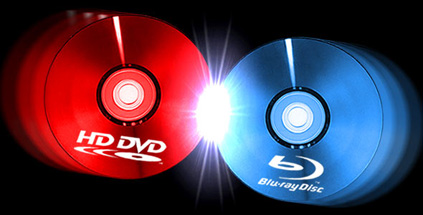|
|
Intermittent Issues:
|

|
The DVD Forum and HD-DVDNew at BOP: Share & Save
![]() Tweet
Tweet
![]() Print this column
Print this column
The entry of what would become HD-DVD onto the playing field was initiated by the two main motivations that brought the Blu-ray specification its problems: cost and form factor. Having witnessed the considerable expenditure needed to adopt infrastructure for the blue laser diode, and the early form factor of Blu-ray discs, the DVD Forum was initially exploring a solution that involved pressing HD content onto dual-layer DVDs. Given what we already know about the space constraints of DVDs, this approach was problematic from the beginning; one suspects it only gained any traction at all as an emergency fallback in case Blu-ray absolutely fell through. Compression techniques and the resulting video quality (both of which we’ll talk about in the next section) were improving continuously, but dual-layer DVDs were already being packed to the gills with SD material: the feature, different audio tracks, making-ofs, deleted scenes. Pandora’s Box had been opened as far as what digital media could provide, and trying to press HD content onto the same storage space would have, one suspects, allowed for the film alone and little to no special features.
The potential solution here was something called low-bitrate encoding, which involved a greater degree of compression and thus a smaller file size for each relevant segment of HD content; however, it also involved two new and different methods of encoding. This was the only feasible way to squeeze HD content onto a standard DVD with the appropriate quality; however, the development of low-bitrate encoding had ramifications far beyond this particular initiative.
An initiative is all it turned out to be; despite the planning and considerable engineering work taken to essentially provide HD product in what was an SD container, the method of encoding was never settled upon, and the DVD Forum ultimately decided to go with the same blue-violet laser diode that Sony chose, which gave them the same 405 nm wavelength to play with; the format that was ultimately adopted by the Forum was christened as HD-DVD, in an attempt to maintain continuity with the existing DVD branding. There was one big difference in their approach, though: the Sony Blu-ray spec utilized a lens with a wider numerical aperture. In plain terms, this meant that the system’s laser stayed more uniform in radiance as it passed from the lens to the surface of the Blu-ray Disc; the effect of this was that the laser could focus on a smaller area, and move with more precision. HD-DVD did not have this wide-aperture lens, and less data could be read from a similar surface area. As a result, each layer of an HD-DVD had a maximum storage capability of 15 gigabytes - significantly below Blu-ray’s 25 gigabytes per layer. There were additional complications with this comparison, which would only show themselves later (we’re getting there, I promise). Fifteen gigabytes was still a healthy distance ahead of DVD’s 4.7 gigabytes per layer, and there was now a blue-laser HD format that fit the expense and form factor of DVD to a closer degree.
|
Advertisement |
All of this took place in 2002; HD optical media was years away from mass production, and yet some of these details had already been relatively public by early 2003. Information was sufficiently both available and complicated enough so that publications began to get some of their wires crossed as to what was really possible with the new format; one particularly memorable forecast utilized the concurrent release of Peter Jackson’s Lord of the Rings films to claim that the format would permit all three Extended Editions to be pressed onto a single disc, in HD. The thing that stuck out the most, though, was the presence of more than one standard. The specter of a format war loomed on the horizon by 2003, and there was pressure on both Sony and the DVD Forum to come to some kind of deal, consolidate their approaches, and avoid a conflict. One was not forthcoming, due to two main reasons.
To isolate the first, we’re going to very briefly step all the way back to the 1990s here, and the establishment of the DVD standard. It was an incredibly smooth launch by comparison, but even here there was some initial disagreement, and two formats were initially created: Multimedia CD (pioneered by Sony and Philips), and Super Density CD (pioneered by just about everyone else). There was the possibility of a conflict and potential format war here, too, except IBM stepped in and mediated the discussions. A war was averted and DVD was launched, but in the process of discussions Sony was made to give up Multimedia CD’s disc structure; this proprietary aspect of the format cost them a large amount of money in royalties. With the HD format, Sony held firm to their disc structure (involving the wide-aperture lens mentioned above), and would not give it up. This was the first major point of contention.
[ Email this column ]

|
|
|

|
Tuesday, April 23, 2024
© 2024 Box Office Prophets, a division of One Of Us, Inc.

